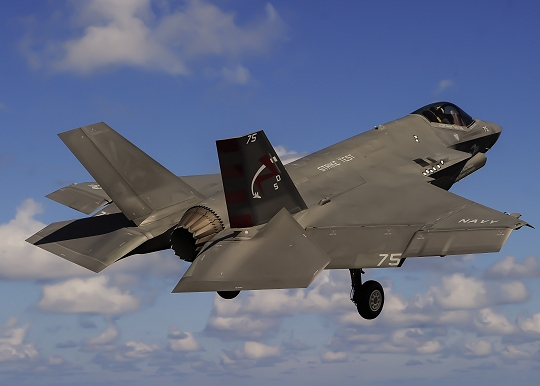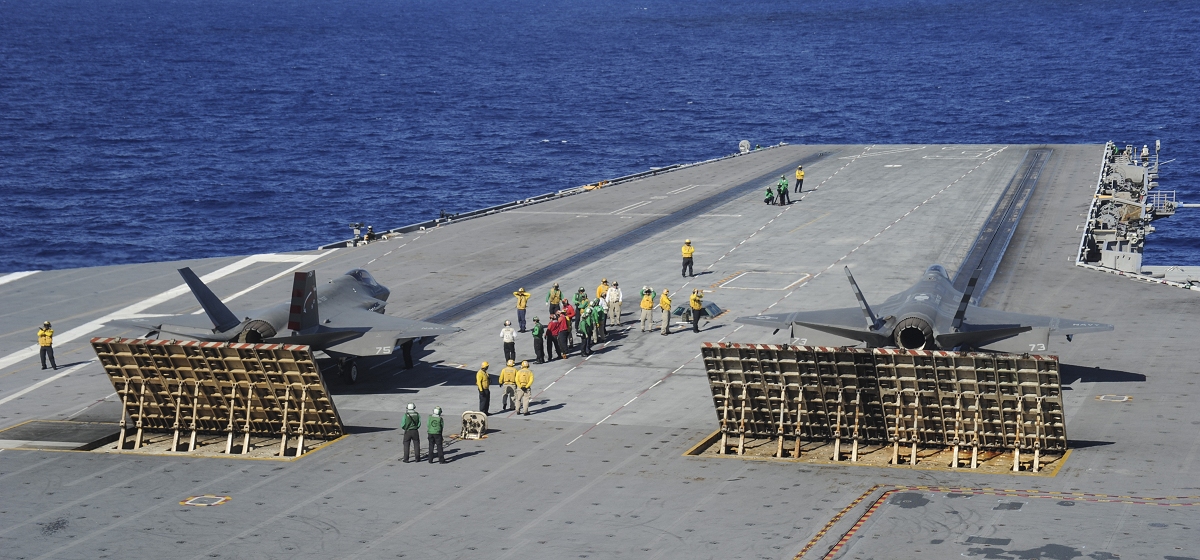 ATLANTIC OCEAN (Aug. 20, 2016) An F-35C Lightning II carrier variant, assigned to the Salty Dogs of Air Test and Evaluation Squadron (VX) 23, flies above the aircraft carrier USS George Washington (CVN 73). (U.S. Navy photo by Mass Communication Specialist 3rd Class Wyatt L. Anthony)
ATLANTIC OCEAN (Aug. 20, 2016) An F-35C Lightning II carrier variant, assigned to the Salty Dogs of Air Test and Evaluation Squadron (VX) 23, flies above the aircraft carrier USS George Washington (CVN 73). (U.S. Navy photo by Mass Communication Specialist 3rd Class Wyatt L. Anthony)As the first director for the Navy's F-35C Joint Strike Fighter (JSF) Fleet Integration Office, I have enjoyed the opportunities and challenges of bringing fifth-generation strike-fighter capabilities to the fleet. As this highly advanced weapons system matures, I am convinced the F-35C will be a cornerstone platform that plays a crucial role in mission success for Carrier Air Wings (CVW), Carrier Strike Groups (CSG) and numbered fleets. The F-35C will be a game-changer for the Navy.
The F-35C Lightning II will introduce next generation strike-fighter aircraft capabilities to the Navy CVW , enabling the CSG and numbered fleets to effectively engage and survive a wide range of rapidly evolving threats, both air and surface, in contested airspace.
The unique capabilities of the F-35C, coupled with the proven capabilities and capacity of current United States Navy fighter aircraft, significantly enhance a CSG's battle space awareness, lethality and survivability. In supporting a principle Department of Defense investment objective of balancing modernization and readiness, the Navy remains committed to selecting the right procurement ramp for F-35C to balance strike-fighter inventory management with the cost and time required to field advanced capabilities. The Navy will maintain and sustain much of its current force in order to guarantee mission success against the threats of today, as well as the high-end threats of the future.
Near-peer adversaries are advancing technologically and economically, resulting in proliferation of highly capable Integrated Air Defense Systems, high performance aircraft and information operations to include:
• Long-range air surveillance radars and airborne early warning aircraft
• Long-range surface-to-air missiles
• Highly maneuverable, low observable adversary aircraft
• Jamming and anti-jamming operations against communication, radar and Global Positioning System satellites
Left unchecked, this threat proliferation will constrain the CSG's ability to project power. As technologies continue to advance, the future air wing will continue to adapt as it always has, particularly to increase its capacity to contribute to the sea control mission, conducting both kinetic and non-kinetic operations. The F-35C will be the CSG's first choice to penetrate and operate in these contested environments, providing a day-one strike capability. Integrated with other fleet assets, the F-35C's tactical agility and strategic flexibility are critical to maintain a long-term decisive tactical advantage.
While the day one capability provided allows the F-35C to perform at the "tip of the spear," its interoperability within the CVW and unique ability to support and augment already fielded legacy platforms is essential to sustaining the Navy's combat lethality now and in the future. In the near term, legacy aircraft will continue to comprise the majority of the CVW. The CVW's inherent integrated capability design will enable the distribution of information collected by F-35Cs to enhance the effectiveness and survivability of all sea, air and land platforms throughout the battle space. The mix of both legacy and next generation aircraft operating from carrier flight decks provides the necessary complementary capability and capacity to pace the rapidly evolving threat…a formula which guarantees the CVW of the future remains lethal, survivable and able to accomplish the full spectrum of CSG and numbered fleet mission sets while providing an effective and affordable balance across the strike fighter inventory.
The Navy expects to deploy the first operational F-35C squadron in 2021. Underpinning this deployment is the service declaration of Initial Operating Capability, which is based on providing a validated and verified combat capable aircraft prior to first deployment. The means to validate that capability is the successful demonstration of operational test in the 3F software configuration. The 3F configured F-35C provides warfighting capability to accomplish primary Navy missions to include: Attack, Close Air Support and Suppression and Destruction of Enemy Air Defense as well as Offensive and Defensive Counter Air.
Follow on modernization capabilities planned for the F-35C program will ensure that a CSG is able to consistently meet and defeat expected advanced threats now and well into the future. Follow on modernization will be implemented in order to continue to advance F-35C capability and improve lethality and survivability across all mission sets and enable operations in areas of increasingly sophisticated threats, leveraging intelligence assessment of the future battlespace.
For the CVW of the future to out-pace the rapidly evolving threat, it is critically important to ensure that F-35C capabilities are integrated and interoperable with existing ships and aircraft within the CSG and the numbered fleets.
Weapons integration, radar improvements, electronic warfare capabilities, interoperability, and real-time information sharing must continue to progress in order to guarantee mission success in the future high-end threat environment. The full integration of these capabilities within the CSG / CVW team, combined with the F-35C's ability to distribute this information across multiple platforms within the numbered fleets, is the cornerstone of how the future Navy will fight and win.
Recognizing Naval Aviation's capability of today and the need for increased capability tomorrow, the Navy remains committed to pursuing the right procurement ramp for F-35C to balance inventory management, affordability and force modernization. A detailed asset allocation study determined that the most efficient and effective composition of strike fighters for the future CVW is two squadrons of F-35C and two of F/A-18E/F. With 10 CVWs , the Navy's objective is to attain 20 F-35C squadrons, two per CVW by the early-2030s. This strategy calls for the continued procurement of low rate initial production aircraft and the enhanced capabilities of Block 3F software, and eventually Block 4's advanced capabilities. The Navy's plan for full rate production optimizes the force for the introduction of next generation capabilities to the Navy in the near term, while allowing the fleet to build the community and work integration solutions.
A Navy CSG requires the speed, endurance, flexibility and ability to operate in hostile environments autonomously.
The F-35C's stealth characteristics, long-range combat identification and ability to penetrate threat envelopes, while fusing multiple information sources into a coherent picture, will enhance the role that the CSG and numbered fleets must play in support of our national interests. Ultimately, with the F-35C integrated and interoperable with the CVW, the CSG of the future will continue to be lethal, survivable and able to accomplish the entire spectrum of mission sets to include day one response to high end threats. The Navy remains dedicated to a capability focused approach as we evolve the CVW and the CSG. The F-35C's capability will provide decision superiority to the nation's warfighters to ensure that if deterrence fails, the United States can conduct decisive combat operations to defeat any adversary.
I look forward to the day in the not-too-distant future when Lightning II is a common participant in training and deployed operations for the Navy. The F-35C will undoubtedly play a critical role in the integrated maritime force that we will depend on to execute Navy's mission for decades to come.



